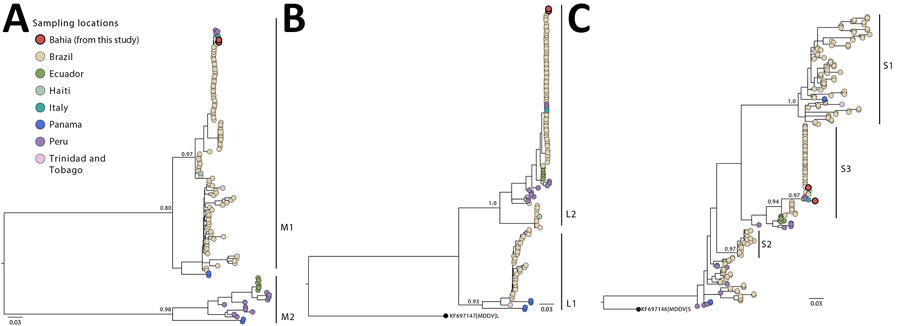Volume 30, Number 11—November 2024
Dispatch
Fatal Oropouche Virus Infections in Nonendemic Region, Brazil, 2024
Figure

Figure. Maximum-likelihood phylogenetic trees of the 3 independent OROV segments from fatal Oropouche virus infections in nonendemic region, Brazil, 2024. A) Medium segment (n = 122); B) large segment (n = 138); C) small segment (n = 264). Tips of prototypical viruses and major clusters are color-coded according to locations of isolation. The trees included annotations indicating the bootstrap probability support for both major lineages and specific clades. Trees were constructed by using IQ-TREE 2 software under the Hasegawa-Kishino-Yano plus gamma 4 substitution model (11). MDDV was included as an outgroup in the large and small segment trees. Scale bars indicate nucleotide substitutions per site. MDDV, Madre de Dios virus; OROV, Oropouche virus.
References
- Sakkas H, Bozidis P, Franks A, Papadopoulou C. Oropouche fever: a review. Viruses. 2018;10:175. DOIPubMedGoogle Scholar
- Moreira HM, Sgorlon G, Queiroz JAS, Roca TP, Ribeiro J, Teixeira KS, et al. Outbreak of Oropouche virus in frontier regions in western Amazon. Microbiol Spectr. 2024;12:
e0162923 . DOIPubMedGoogle Scholar - Pinheiro F, Pinheiro M, Bensabath G, Causey OR, Shope RE. Oropouche virus epidemic in Bethlehem [in Tetum]. Revista do Serviço Especial de Saude Publica. 1962;12:13–23.
- Pereira CS, Picanço MRS, Vale GP, Oliveira CS, Amorim FAS, Costa FS, et al. Epidemiology, diagnosis and treatment of Oropouche fever in Brazil: a literature review [in Portuguese]. Brazilian J Health Rev. 2021;4:23912–20. DOIGoogle Scholar
- Fonseca LMDS, Carvalho RH, Bandeira AC, Sardi SI, Campos GS. Oropouche virus detection in febrile patients’ saliva and urine samples in Salvador, Bahia, Brazil. Jpn J Infect Dis. 2020;73:164–5. DOIPubMedGoogle Scholar
- Lorenz C, Chiaravalloti-Neto F. Brazil reports an increased incidence of oropouche and mayaro fever in the amazon region. Travel Med Infect Dis. 2024;58:
102692 . DOIPubMedGoogle Scholar - Naveca FG, Nascimento VAD, Souza VC, Nunes BTD, Rodrigues DSG, Vasconcelos PFDC. Multiplexed reverse transcription real-time polymerase chain reaction for simultaneous detection of Mayaro, Oropouche, and Oropouche-like viruses. Mem Inst Oswaldo Cruz. 2017;112:510–3. DOIPubMedGoogle Scholar
- Claro IM, Ramundo MS, Coletti TM, da Silva CAM, Valenca IN, Candido DS, et al. Rapid viral metagenomics using SMART-9N amplification and nanopore sequencing. Wellcome Open Res. 2023;6:241. DOIPubMedGoogle Scholar
- Katoh K, Rozewicki J, Yamada KD. MAFFT online service: multiple sequence alignment, interactive sequence choice and visualization. Brief Bioinform. 2019;20:1160–6. DOIPubMedGoogle Scholar
- Larsson A. AliView: a fast and lightweight alignment viewer and editor for large datasets. Bioinformatics. 2014;30:3276–8. DOIPubMedGoogle Scholar
- Nguyen L-T, Schmidt HA, von Haeseler A, Minh BQ. IQ-TREE: a fast and effective stochastic algorithm for estimating maximum-likelihood phylogenies. Mol Biol Evol. 2015;32:268–74. DOIPubMedGoogle Scholar
- Brazilian Ministry of Health. Oropouche [cited 2024 Aug 27]. https://app.powerbi.com/view?r=eyJrIjoiMzc0Mzg3NjMtMzBiNy00ODhhLWJhNmItZmYzYWM4ZjUxN2Q0IiwidCI6IjlhNTU0YWQzLWI1MmItNDg2Mi1hMzZmLTg0ZDg5MWU1YzcwNSJ9
- Mourãão MP, Bastos MS, Gimaqu JBL, Mota BR, Souza GS, Grimmer GHN, et al. Oropouche fever outbreak, Manaus, Brazil, 2007-2008. Emerg Infect Dis. 2009;15:2063–4. DOIPubMedGoogle Scholar
- Araújo R, Dias LB, Araújo MT, Pinheiro F, Oliva OF. [Ultrastructural changes in the hamster liver after experimental inoculation with Oropouche arbovirus (type BeAn 19991)] [in Portuguese]. Rev Inst Med Trop Sao Paulo. 1978;20:45–54.PubMedGoogle Scholar